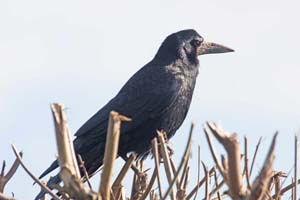Previous Rook research
If you have watched corvids in your garden won’t be surprised that their intelligence could be on par with that of some great apes and cetaceans. Whether it is Jackdaws learning to feed from a hanging feeder or a Jay caching food for the future, the astuteness of corvids is evident in our gardens every day.
Corvids in the wild
Many corvids live in large social groups and exhibit social intelligence. The complexity of their societies means that they have to be able to do things like recognise individuals and track social positions. Whilst this sounds fairly straight forward, it is actually quite complicated. A corvid is also the only bird to have apparent self-awareness. A study looked at this by placing coloured stickers on the necks of Eurasian Magpies which they could only see in the mirror. The individuals did not notice the sticker until they looked in the mirror, at which point they tried to scratch it off. The scientists also tried this with a black sticker, placing it on black feathers, and none of the birds appeared to notice it.
A lot of corvids exhibit clever behaviour when it comes to food. Caching behaviour, hiding food to eat later, is common but the Western Scrub-jay has taken this one step further by not only remembering where the food is, but guarding it against other jays. Competing birds may steal from each other’s caches to bury elsewhere, but the Western Scrub-jay will move its stash if it sees another bird around. It is thought that this shows the ability to understand other birds’ intentions. Another behaviour revealed in corvids is the ability to make and use tools. A famous example of this is the New Caledonian Crow which is known to create a hook from a twig in order to extract insects from crevices in tree bark in the wild.
Rook lab studies
Rooks, like other corvids, are also extremely intelligent, and research shows that they are able to solve complex social and ecological problems. Lab studies have been run by scientists from the University of Cambridge and Queen Mary University of London, looking at problem-solving behaviour in Rooks which showed that they were able to select tools to solve a puzzle in order to retrieve an item of food, by themselves and cooperatively.
Puzzles provided included using a specific size of stone to open a trap door with food behind, or using one tool to get another in order to get food. What stood out most from this study, however, was the fact that Rooks are not thought to use tools in the wild, unlike other corvid species like the New Caledonian Crows, and yet in one test they made a tool. When presented with a small bucket in a tube that contained a worm, and a length of wire next to it, each bird in the study made a hook out of the wire before trying any other way to retrieve the food, and used it to pull the bucket up. It is thought that this ability may have come from an ancient ancestor that evolved the capacity to use tools, but as the pressure of finding food diminished, the use of tools died out.
Rooks in the garden
While they might not be fashioning tools, Rooks in gardens have been known to solve problems when trying to get food, ranging from learning to use hanging feeders to pulling up food on a string with their feet. Watch the video taken by John Charles.







Share this page